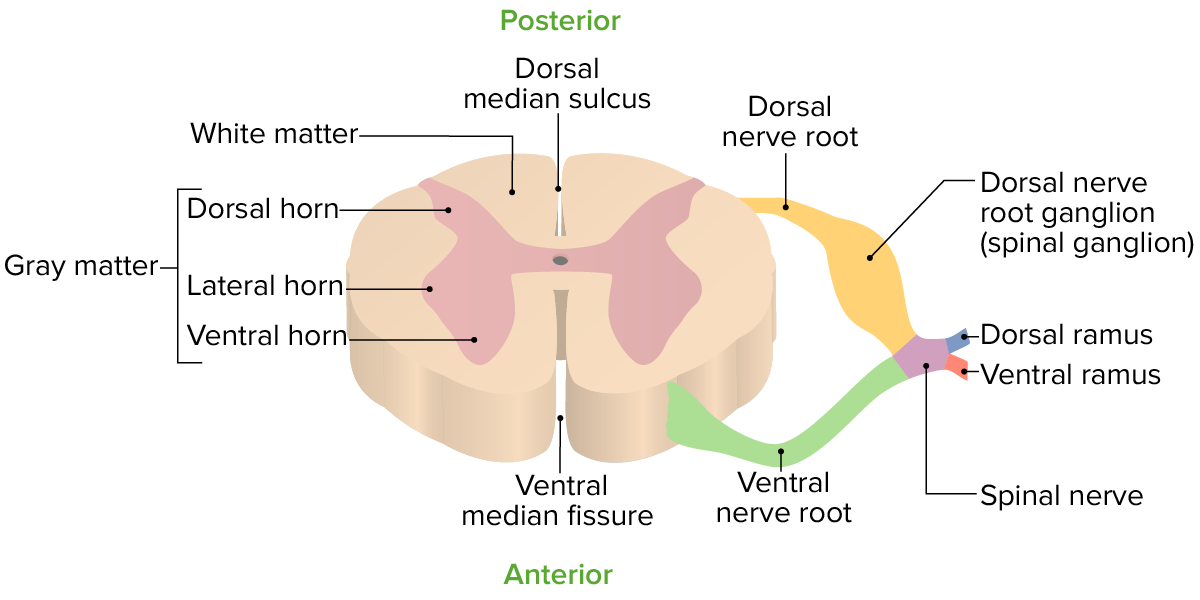Playlist
Show Playlist
Hide Playlist
Case: 53-year-old Man with Numbness in Lower Extremities
-
Slides Diseases of the Spinal Cord.pdf
-
Download Lecture Overview
00:00 Now let's talk about intradural intramedullary pathology that's not MS, other spinal cord disorders that may not be classic multiple sclerosis. And let's turn to a case. 00:13 This is a 53-year-old with diabetes, hypertension, and hyperlipidemia who presented yesterday with right upper extremity pain, improving with nitroglycerin. He was evaluated for cardiac causes and admitted to the internal medicine service for work-up which was unremarkable. He was also noted to have new numbness in the left leg that improved during evaluation. He was discharged home and went to sleep in his recliner. He awoke with worsening numbness in the left leg from the waist to the feet, so asymmetric sensory changes below the waist. The numbness in the left leg worsened extending up to the abdomen and then moving to the right lower extremity. So we see this asymmetric process starting initially in the left leg and then moving to the right leg. He tried to stand but was unable to get out of his bed. 00:58 He denies bowel, bladder dysfunction but has not been able to avoid today and we may be seeing early signs of urinary retention. Examination shows 4/5 grip strength, 4/5 hip flexor strength, knee flexor, knee extensor, 3/5 dorsi and plantarflexion all in the left side. The important things here is he is weak below a level and we're starting to see asymmetry that could be seen in a subcortex brainstem or spinal cord disorder. 01:28 There is hyperreflexia in the bilateral lower extremities, 2+ biceps and brachioradialis so also some asymmetry in terms of the upper motor neuron reflex exam in the legs and normal in the arms. Plantar responses are flexor bilaterally. Sensory testing shows a T4 sensory level to temperature. Light touch, vibration, and proprioception are intact. And that's very very important. It underscores the reason to do a detailed sensory exam. The finding of the sensory level really are used in favor of a spinal cord disorder or myelopathy as opposed to brainstem or brain in this patient. Here, there are some key features that we should pick up on in this case. One is asymmetric presentation of weakness, the second is the hyperreflexia which points to an upper motor neuron or central nervous system disorder, and the sensory level is key. 02:18 This tells us we need to hone in on spinal cord pathology in the thoracic or cervical spine in this patient. And here is the MRI of the spine in this patient. Here, we see multiple T2 segments in the cervical spine. We do see some degenerative changes in the cervical spine which is not uncommon and seen in many patients, but importantly we also see cord signal changes. T2 flare, T2 bright areas, hyperintense areas in the lower cervical spine below that area of degeneration that may be a cause for concern in this patient. If we look at the axial sections in that area, again, we see asymmetric cord signal changes that are suggestive of some new process that is affecting this patient's spinal cord. If we think about their clinical presentation, this was rapid onset of an asymmetric paraparesis, not something that we would see with an externally compressive process. We don't have pain which we said we would see with an externally compressive process and we're starting to have evidence of bowel or bladder dysfunction with a difficulty with voiding which we do see with an intradural and intramedullary process. So here, even though there is evidence of spinal cord compression, what's most concerning in this patient is this cord signal change and the possibility of an infectious, inflammatory, or neoplastic intramedullary spinal cord disorder.
About the Lecture
The lecture Case: 53-year-old Man with Numbness in Lower Extremities by Roy Strowd, MD is from the course Diseases of the Spinal Cord.
Included Quiz Questions
A patient has a T4 sensory level deficit, manifested as an inability to distinguish the difference between a hot and a cold test tube placed on the upper chest, near the nipples. The disorder is most likely at the level of the...
- ...spinal cord.
- ...brainstem.
- ...brain.
- ...peripheral nerves.
Intramedullary spinal cord changes in signal intensity on T2-weighted MRI imaging are most likely caused by... (Select all that apply.)
- ...infection.
- ...an extradural compressive tumor.
- ...a noninfectious inflammatory process.
- ... a neoplastic process.
Customer reviews
5,0 of 5 stars
| 5 Stars |
|
5 |
| 4 Stars |
|
0 |
| 3 Stars |
|
0 |
| 2 Stars |
|
0 |
| 1 Star |
|
0 |




